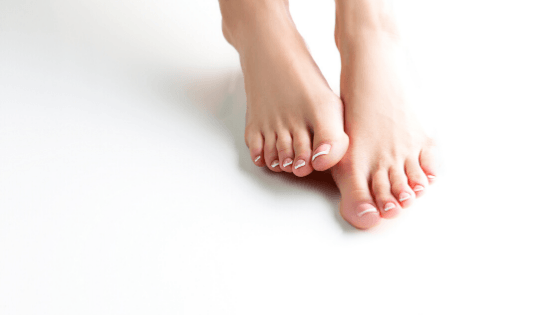Why do you have toenails? What should you do if your toenails turn a different color? How should you cut your toenails? Toenails may be something that you don’t think about, until you have an issue! Toenails are there to protect your toes. They are made of keratin, which is the same protein that is found in your skin, hair, and of course fingernails. Keratin makes your toenails tough and able to withstand against every day wear and tear. Unfortunately, if you don’t take proper care of your toenails you may end up with discoloration or even an infection. Here are some common toenail issues and what you can do to prevent them.
Ingrown Toenails : Ingrown toenails are usually caused by trimming toenails too short, particularly on the sides of the big toes. They may also be caused by shoes that are too tight or short, injury, fungus infection, heredity, or poor foot structure. Ingrown toenails occur when the corners or sides of the toenail dig into the skin, often causing pain, redness, swelling, and even infection. Ingrown toenails can be prevented by:
- Trimming toenails straight across with no rounded corners.
- Ensuring that shoes and socks are not too tight.
- Keeping feet clean at all times.
In most cases, treating ingrown toenails is simple: soak the foot in warm, soapy water several times each day. Gently massage the side of the nail fold to help reduce the inflammation. Avoid wearing tight shoes or socks. Antibiotics are sometimes prescribed if an infection is present. Avoid attempting “bathroom surgery.” Repeated cutting of the nail can cause the condition to worsen over time. Don’t cut a notch in the toenail or place cotton under the nail. If your symptoms fail to improve, it is time to see a foot and ankle surgeon .
Yellow Toenails: The most common cause of yellow discoloration in the toenails is a fungal infection. The fungus often develops underneath the nail, resulting in it becoming thick, raised, and yellow in color.
Other potential causes for yellow discoloration of the nail include diabetes mellitus and lymphedema (chronic leg swelling). Yellow staining of the nails can also occur in individuals who use nail polish. A stained nail may take several months to grow out.
Black Toenails: When there has been trauma to the toenail, it may turn a black, purple, or brownish color. This is caused by a blood clot or bleeding under the nail. If it gets very painful and the entire nail is involved, you may need to see your Podiatrist to relieve the pressure caused by the bleeding.
When the second or third toenails are involved, it is commonly referred to as “runner’s toe.” This can be the result of the nail being slightly too long and the shoe being either too big or too tight. If the shoe is too big, when running down hill, the foot slips and the nail can get caught where the toe cap meets the toebox. If the shoes are too tight, the nail can get pinched and jammed, resulting in bleeding between the nail plate and nail bed.
Although it is very rare, a more serious cause of black toenails is malignant melanoma. Since early diagnosis and treatment of melanoma improves the chances for a good outcome, it is important that all black toenails be evaluated by a qualified foot and ankle surgeon to rule out this cause. Other rare causes of black toenails include fungal infections, chronic ingrown nails , or health problems affecting the rest of the body.
Thick Toenails
Toenails will often become thick as an individual grows older. Thickening may also occur as a result of trauma to the toenail, such as when it repeatedly hits the end of a shoe that is too short. Sometimes when something is dropped on the toenail, the nail will fall off. When a new toenail grows back, it will often be thicker than it was previously.
Thick toenails can also be seen in individuals with nail fungus, psoriasis, and hypothyroidism. Those who have problems with the thickness of their toenails should consult a foot and ankle surgeon for proper diagnosis and treatment.
Keeping your toenails properly trimmed and cleaned is a big part of your foot health. If you are experiencing any toenail issues or other foot and ankle issues, contact Dr. Kylin Kovac or Dr. Jed Erickson at Idaho Foot and Ankle Center. They are dedicated to treating foot and ankle problems and helping you get back on your feet.
Some content provided by The ACFAS.



Recent Comments